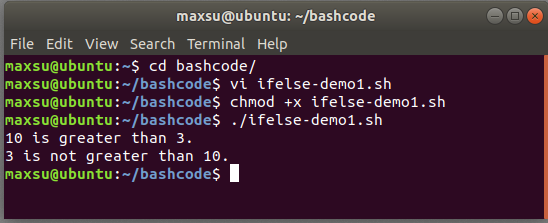Bash if-else語句
在本小節中,我們將了解如何在Bash指令碼中使用if-else語句來完成自動化任務。
Bash if-else語句用於在語句的順序執行流程中執行條件任務。有時,如果if條件為真,我們想處理一組特定的語句,但是如果if條件為假,則要處理另一組語句。要執行此類操作,可以應用if-else機制。們可以使用if語句應用條件。
if-else語法
Bash Shell指令碼中if-else語句的語法定義如下:
if [ condition ];
then
<if block commands>
else
<else block commands>
fi
以上語法有幾個要點:
- 可以使用一組使用條件運算子連線的一個或多個條件。
- 其他塊命令包括一組在條件為假時執行的動作。
- 條件表示式後的分號(
;)是必須的。
參考以下範例,演示如何在Bash指令碼中使用if-else語句:
範例1
下面的範例包含兩個不同的場景,在第一個if-else語句中條件為true,在第二個if-else語句中條件為false。
指令碼檔案:ifelse-demo1.sh
#!/bin/bash
#when the condition is true
if [ 10 -gt 3 ];
then
echo "10 is greater than 3."
else
echo "10 is not greater than 3."
fi
#when the condition is false
if [ 3 -gt 10 ];
then
echo "3 is greater than 10."
else
echo "3 is not greater than 10."
fi
執行上面範例程式碼,得到以下結果:
在第一個if-else表示式中,條件(10 -gt 3)為true,因此執行if塊中的語句。而在另一個if-else表示式中,條件(3 -gt 10)為false,因此執行else塊中的語句。
範例2
在此範例中,演示如何在Bash中的if-else語句中使用多個條件。使用bash邏輯運算子來加入多個條件。
指令碼檔案:ifelse-demo2.sh
#!/bin/bash
# When condition is true
# TRUE && FALSE || FALSE || TRUE
if [[ 10 -gt 9 && 10 == 9 || 2 -lt 1 || 25 -gt 20 ]];
then
echo "Given condition is true."
else
echo "Given condition is false."
fi
# When condition is false
#TRUE && FALSE || FALSE || TRUE
if [[ 10 -gt 9 && 10 == 8 || 3 -gt 4 || 8 -gt 8 ]];
then
echo "Given condition is true."
else
echo "Given condition is not true."
fi
執行上面範例程式碼,得到以下結果:
在一行if-else語句
可以在一行中編寫完整的if-else語句以及命令。需要遵循以下一些規則才能在一行中使用if-else語句:
- 在
if和else塊的語句末尾使用分號(;)。 - 使用空格作為分隔符來追加其他語句。
下面給出一個範例,演示如何在單行中使用if-else語句:
範例
指令碼檔案:ifelse-single-line.sh
#!/bin/bash
read -p "Enter a value:" value
if [ $value -gt 9 ]; then echo "The value you typed is greater than 9."; else echo "The value you typed is not greater than 9."; fi
執行上面範例程式碼,得到以下結果:
巢狀if-else語句
與巢狀的if語句一樣,if-else語句也可以在另一個if-else語句中使用。在Bash指令碼中將它稱為巢狀if-else。
下面是一個範例,演示如何在Bash中巢狀if-else語句。
指令碼檔案:ifelse-nested.sh
#!/bin/bash
read -p "Enter a value:" value
if [ $value -gt 9 ];
then
if [ $value -lt 11 ];
then
echo "$value>9, $value<11"
else
echo "The value you typed is greater than 9."
fi
else echo "The value you typed is not greater than 9."
fi
執行上面範例程式碼,得到以下結果: